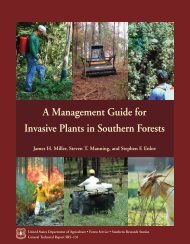Introduction - Stored Grain Pest Management Pest Management for ...
Introduction - Stored Grain Pest Management Pest Management for ...
Introduction - Stored Grain Pest Management Pest Management for ...
You also want an ePaper? Increase the reach of your titles
YUMPU automatically turns print PDFs into web optimized ePapers that Google loves.
There are requirements <strong>for</strong> the reporting of product theft to local police, and <strong>for</strong> DOTtransportation labels when the product is transported.FUMIGATION MANAGEMENT PLANA fumigation management plan (FMP) must be pre-pared by the certified applicator <strong>for</strong>each structure to be fumigated (See Appendix 1 and 2). This plan is designed to ensure asafe and effective fumigation, and must fully characterize the area to be fumigated, andinclude all appropriate monitoring and notif-ication requirements. The development of afumig-ation management plan is quite involved so we will spend some time on this.In order to develop an effective Fumigation <strong>Management</strong> Plan, the following proceduresneed to be followed:The certified applicator must inspect the structure and surroundings to determinesuitability <strong>for</strong> fumigation. If sealing is required, review records to determine if structuralchanges may have resulted in new potential leaks.• Seal all leaks and test the seal, plus monitor phosphine levels in adjacentoccupied buildings to ensure safety.• Review existing Fumigation <strong>Management</strong> Plans, Material Data Safety Sheets, thelabel/applicator’s manual, and safety procedures be<strong>for</strong>e fumigating.• Develop procedures and safety measures <strong>for</strong> other workers that will be in andaround the fumigation area during application and aeration.• Develop a monitoring plan that confirms that workers and bystanders are notexposed to levels above the allowed limits during application, fumigation, andaeration. This monitoring plan must also demonstrate that nearby residents arenot exposed to unacceptable levels, as well. The levels <strong>for</strong> exposure are an 8 hourtime-weighted average of 0.3 ppm or a 15 minute time-weighted short termexposure limit of 1.0 ppm.• Develop a procedure with local authorities to notify nearby residents in the eventof an emergency.• Confirm the placement of placards to secure all entrances to any structure underfumigation.• Ensure that the required safety and monitoring equipment and adequatemanpower is available to conduct a safe fumigation. More recent respiratoryprotection guidelines <strong>for</strong> workers and certified applicators, require the use ofmonitoring equip-ment to establish airborne concentrations. Between 0 and 0.3ppm, no respiratory protection is required. At concentrations from 0.3-15 ppm, aNIOSH/MSHA approved full – face canister respirator is required (Figure 1.21).If the phosphine concentration is above 15 ppm or if it is not known, a selfcontainedbreathing apparatus (SCBA) is required (Figure 1.22).
















